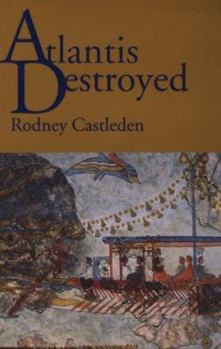Atlantis Destroyed
Select Format
Select Condition 
Book Overview
Plato's legend of Atlantis has become notorious among scholars as the absurdest lie in literature. Atlantis Destroyed explores the possibility that the account given by Plato is historically true.
Rodney Castleden first considers the location of Atlantis re-examining two suggestions put forward in the early twentieth century; Minoan Crete and Minoan Thera. He outlines the latest research findings on Knossos and Bronze Age Thera, discussing the...
Format:Paperback
Language:English
ISBN:0415247594
ISBN13:9780415247597
Release Date:January 2001
Publisher:Routledge
Length:240 Pages
Weight:0.77 lbs.
Dimensions:0.5" x 6.1" x 9.2"
Customer Reviews
2 ratings
An archaeological and historical perspective on Atlantis
Published by Thriftbooks.com User , 23 years ago
Of all the books I've read on Atlantis, the most impressive (and the one with the most archaeological evidence) is Rodney Castleden's Atlantis Destroyed. Castleden also wrote The Making of Stonehenge, The Knossos Labyrinth, The Stonehenge People, Neolithic Britain, and Minoans: Life in Bronze Age Crete. His basic argument is that Plato took a number of what he calls "pieces of identifiable proto-history" and wove them together into a contemporary commentary on the world. Castleden suggests that the basis of this is a faint memory of Minoan civilization. He points out what is often forgotten by those who take the Atlantis story literally, that for Plato it is Athens that is written about as a utopia, not Atlantis, Athens that is the "excellent land with well-tempered seasons."He illuminates several puzzles that have misled many people, eg. Plato's comments about the Pillars of Hercules. This is often assumed to refer to the modern day features by that name, but in ancient Greece the term could have other meanings, eg it could refer to the two southward-pointing headlands on each side of the Gulf of Laconia. Thus the large island outside the pillars of Heracles would be Crete.Castleden follows this with a very detailed discussion of the archaeology and geography of Minoan Crete and Thera and how that compares with Plato's tale. He goes into detail about how the story might have been transmitted to Plato and Plato's possible motives in writing the two essays. (He also mentions that there was a century older text by Hellanicus, of which only a small fragment survives, called 'Atlantis'!).He suggests that the size of 'Atlantis' was distorted by a misreading of either Linear A or B numerals or hieratic or demotic copies made by Egyptian scribes sometime since the fifteenth century, multiplying dimensions by ten so that the Plain of Mesara, which would fit into Crete, became the size of the southern Aegean and Atlantis thus became too large to be in the Mediterranean. A similar problem changed the 900 years between the eruption of Thera and Solon's visit to Egypt to 9000 years. If this is the case it becomes much easier to reconcile the relatively accurate description Plato gives of bronze age Athens with the story of Atlantis (something usually ignored by those who take the Atlantis part of Plato's story literally). What he is not arguing is that either Minoan Crete or Cyladic Thera was Atlantis. He is suggesting that instead Plato drew his story of Atlantis from proto-historical elements about both civilizations. He also suggests that Plato draws from Syracuse (eg the fortifications of Syracuse) and Sparta for both physical descriptions and some of his political commentary, writing circumspectly so as to avoid Socrates fate.He provides a wealth of archaeological evidence and the book is generously sprinkled with sketches and photographs. He even goes into detailed points such as the fact that Santorini (destroyed by a massive volca
Atlantis Destroyed: the story of a story.
Published by Thriftbooks.com User , 24 years ago
For most of us the very word "Atlantis" conjures up the image of an ultra futuristic civilization fated to destroy itself and sink into the ocean. Sort of the Hollywood version. Certainly it is this version that inspires so many New Age thinkers to look for its remains throughout the world. A geologist would tell them that continents can't sink; they can be transgressed (by elevated sea levels) or depressed (by glaciers) but the density gradients among continental granites, oceanic basalts and the materials of the mantal prevent continents from sinking. For the historian working with Plato's tale, it represents a mystery. Mr. Castleden has followed the leads in this mystery and ultimately identified the island of Thera, modern Santorini, as the most likely candidate for the original inspiration for Plato's tale. Sometime during the 1500s BC (or according to others the 1700s BC) the volcano on this island is known to have collapsed causing an eruption that has been estimated by some to have been 100 times more violent than that on Krakatoa during the 19th Century AD. The civilization that was buried when much of the island was destroyed was quite advanced for the time. Although much of the data Castleden has amassed supports this identification, his ultimate thesis is that the story was reworked by Plato for his own purposes. Though it may have been a tale known to him from other sources, it became in Plato's hands, a parable. Castleden believes that Atlantis became a paradigm for the cities of Sicily and Athens during Plato's time. The book is an interesting and thorough treatment of the subject but can be tough going at times. I put it down several times before I really got into it enough to finish it--and kept checking to see how many pages were left to go!






